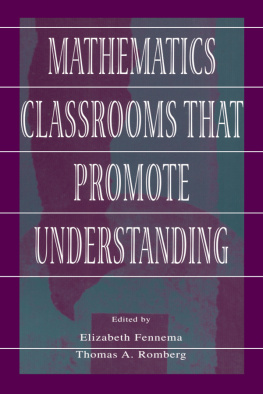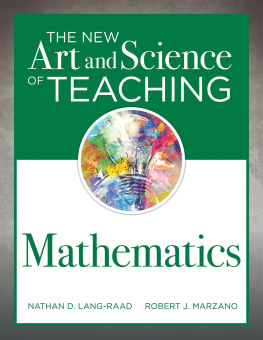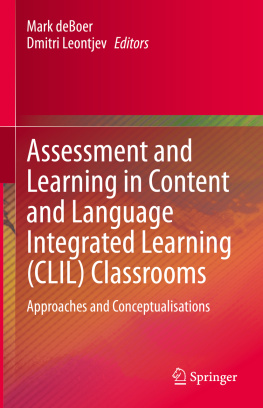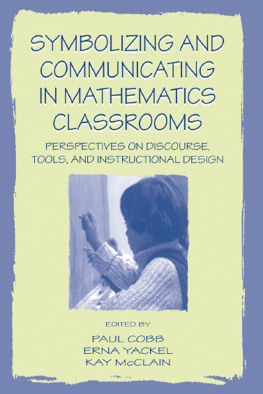Thomas A. Romberg
University of Wisconsin-Madison
James J. Kaput
University of Massachusetts-Dartmouth
When authors in this book describe classrooms that promote mathematical understanding, they each attempt to answer the question: What mathematics is it that students are expected to understand? The answers these authors give, however, may surprise some readers because although the titles of the mathematical domains describednumber, geometry, quantities, statistics, and algebraare familiar, the approach to discussing them is not. Rather than providing a list of specific concepts and skills to be mastered as has often been done in the past, each author focuses on a few key ideas in a domain, the interconnections between them, and examples of how students can grasp an understanding of the ideas as a consequence of exploring problem situations. The descriptions of mathematical content in this book are based on the epistemological shift in expectations about school mathematics that has emerged during the past decade; the chapters reflect attempts to redefine content in light of that shift.
The purpose of this chapter is to examine the scope of the mathematical content we expect students to understand after they have participated in the mathematical curricula described. This chapter has been organized under four headings: (a) traditional school mathematics, to clarify what the shift is away from; (b) mathematics as a human activity, to portray the direction the shift is toward; (c) mathematics worth teaching, to provide an overview to the answers provided in the following chapters to the initial question (What is it that students are expected to understand?); and, finally, (d) speculations about school mathematics in the future.
Traditional School Mathematics
Mathematics is perceived by most people as a fixed, static body of knowledge. Its subject matter includes the mechanistic manipulation of a variety of numbers and algebraic symbols and the proving of geometric deductions. This perception has determined the scope of the content to be covered and the pedagogy of the school mathematics curriculum. Specific objectives, which students are to master, have been stated; the teachers role has been to demonstrate how a manipulation is to be carried out or to explain how a concept is defined; and students have been expected to memorize facts and to practice procedures until they have been mastered.
The arithmetic of whole numbers, fractions, decimals, and percents represents the majority of the first 7 of 8 years of the school mathematics curriculum for all students. For those students who successfully complete the hurdles along the arithmetic path, yearlong courses in algebra and geometry follow. Then, for many college-bound students, what follows is a second-year course of algebra and perhaps a year course of precalculus mathematics. Finally, for a few students, a course in calculus is often available. In each course, the emphasis is on mastering a collection of fixed concepts and skills in a certain order. This layer-cake structure that we have inherited is deeply embedded not only in our curricular structure but in our larger societys expectations regarding schools. This approach to mathematics education reinforces the tendency to design each course primarily to meet the prerequisites of the next course. This layer-cake filtering system is responsible for the unacceptably high attrition from mathematics that plagues our schools.
The traditional three-segment lesson, which has been observed in many classes, involves an initial segment where the previous days work is corrected. Next, the teacher presents new material, often working one or two new problems followed by a few students working similar problems at the chalkboard. The final segment involves students working on an assignment for the following day.
This mechanistic approach to instruction of basic skills and concepts isolates mathematics from its uses and from other disciplines. The traditional process of symbol manipulation involves only the deployment of a set routine with no room for ingenuity or flair, no place for guesswork or surprise, no chance for discovery; in fact, no need for the human being. Furthermore, the pedagogy of traditional instruction includes a basal text (which is a repository of problem lists), a mass of paper-and-pencil worksheets, and a set of performance tests. There is very little that is interesting to read. Workbook mathematics thus gives students little reason to connect ideas in todays lesson with those of past lessons or with the real world. The tests currently used ask for answers that are judged right or wrong, but the strategies and reasoning used to derive answers are not evaluated. This portrayal of school mathematicsa tedious, uninteresting path to follow, with lots of hurdles to clearbears little resemblance to what a mathematician or user of mathematics does. What is clear is that students do not do mathematics in traditional school lessons. Instead, they learn a collection of techniques that are useful for certain purposes. Because mastery of techniques is defined as knowledge, the acquisition of those techniques becomes an end in itself, and the student spends his or her time absorbing what other people have done.
Traditional school mathematics has failed to provide students with any sense of the importance of the disciplines historical or cultural importance, nor any sense of its usefulness. Is it any wonder that many students dislike mathematics and fail to learn it? The premise of this book is that traditional teaching and learning of mathematics has not enabled students to learn mathematics with understanding and that our first step must be to redefine mathematics.
Mathematics as a Human Activity
School mathematics should be viewed as a human activity that reflects the work of mathematiciansfinding out why given techniques work, inventing new techniques, justifying assertions, and so forth. It should also reflect how users of mathematics investigate a problem situation, decide on variables, decide on ways to quantify and relate the variables, carry out calculations, make predictions, and verify the utility of the predictions. Underlying this perspective of human activity is our use of Thurstons (1990) metaphor of a tree to describe the discipline of mathematics:
Mathematics isnt a palm tree, with a single long straight trunk covered with scratchy formulas. Its a banyan tree, with many interconnected trunks and branchesa banyan tree that has grown to the size of a forest, inviting us to climb and explore, (p. 7)
For school mathematics, this vision emphasizes human actions, climbing and exploring. Thurstons image of mathematics as the everspreading banyan tree reflects the notion that mathematics is a plural noun in that there are several intertwined trunks or branches (strands or domains). Furthermore, this image extends to the trees ever-widening root system, drawing in the wide range of activities, interests, linguistic capability, kinesthetic sense, and informal knowledge that students bring to us. It is this broadly inclusive metaphor of mathematics, and the exploration of problems as a way of learning mathematics, that underlies all the subject matter examples of this book.
The discipline of mathematics involves a vast assemblage of ideas in several related content domains and is defined by the community of mathematicians, mathematics educators, and users of mathematics (Hersh, 1997). The content domains have been derived via a continually evolving, culturally shared science of patterns and languages, which is extended and applied through systematic forms of reasoning and argument. Mathematics is both an object of understanding and a means of understanding. These patterns and languages are an essential way of understanding the worlds we experiencephysical, social, and even mathematical. Mathematics is ever aliveas alive as any branch of science todayand is neither static nor fixed in time, but changing. Because mathematics evolves, so also must the school curriculumthe educational organization and sequencing of that content.



![Margaret (Peg) Smith - The Five Practices in Practice [Middle School]: Successfully Orchestrating Mathematics Discussions in Your Middle School Classroom](/uploads/posts/book/416798/thumbs/margaret-peg-smith-the-five-practices-in.jpg)





